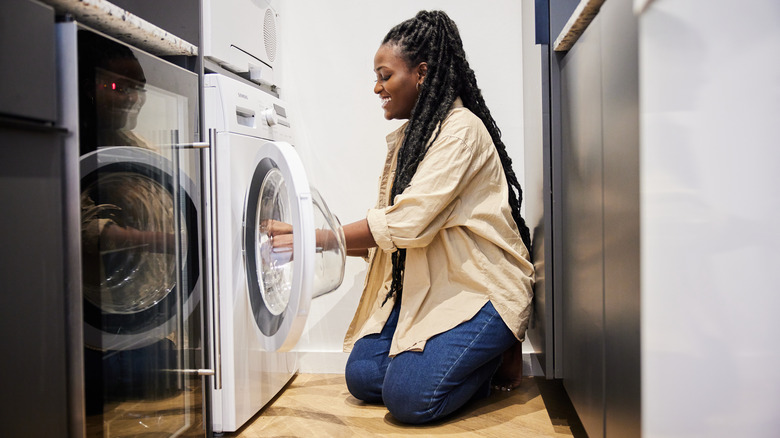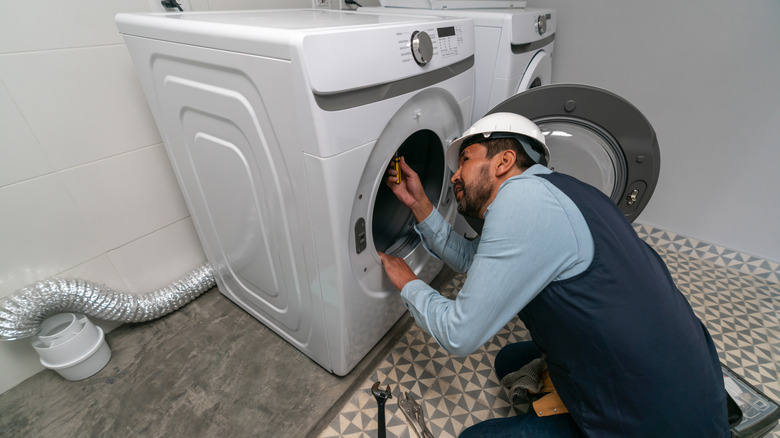TikTok's Dryer Vent Hack Can Keep Your Home Warmer, But Is It Safe? Our HVAC Expert Weighs In
Our heating bills each winter quickly become expensive as we combat the frigid temperatures coming our way. Finding tricks to help contain as much heat as possible around the home and cut down on those costs is top of mind for many. TikTok creators are sharing a heating hack with the platform's users and encouraging anyone with an electric dryer to try it. Influencers are unhooking their dryer hose from outside, pulling it indoors, and attaching a dryer duct lint box to it — available on Amazon or in local hardware stores. This creates a makeshift vent for the expelled hot air from your dryer to strain through, warming up the house. Some TikTok users are even DIYing vents using a 5-gallon bucket, toilet flange, and porch screening.
These videos show the before and after effects of this hack by recording the change in temperature on their thermostats, and it does indeed seem to work. Some videos have garnered over 1 million views and well over 50,000 likes, but is this actually safe to implement in your home? House Digest spoke in an exclusive interview with Traci Fournier, Vice President of Operations at One Hour Heating & Air Conditioning, to gauge whether or not this is something homeowners should be considering and executing. She tells us that despite how it may seem, many risks come with this home hack, including fire hazards, carbon monoxide threats, airflow restriction, lint buildup, and excess moisture that can lead to odors and mold growth.
Health and safety risks
The TikTok hack of hooking your electrical dryer hose up to a dryer lint box and allowing it to heat your home may look like a fool-proof trick, but it poses health and safety risks. "Dryer duct lint boxes are not designed to handle the heat produced by a dryer," said Traci Fournier in an exclusive interview with House Digest. "Using them as a heat filter may pose a significant fire hazard, as they may not be able to withstand high temperatures and, in turn, may cause a fire to ignite." Fires caused by electric dryers are more common than one might think, with the National Fire Protection Agency releasing a 2020 report that 78% of fires caused by dryers originate from electrical appliances. The study also found that 27% of dryer fires originate from lint and other fibers catching fire.
However, there are not just fire hazards to worry about; carbon monoxide is also a threat. "If the lint box is not properly sealed or if there are leaks, there's a risk of carbon monoxide entering the living space," Fournier explained. "Carbon monoxide is a colorless, odorless gas that can be harmful or even fatal in high concentrations." Additionally, many TikTok tutorials noted a rise in humidity and moisture. Fournier confirms this will be an issue and warns us that it can harm our health. "Moist air can promote the growth of mold and mildew, which can lead to respiratory problems and more serious illnesses."
Appliance and system damages
While hooking your electric dryer's hose to a dryer duct lint box to help heat the house poses many health and safety risks, you are not only creating dangerous conditions for yourself but also gambling with the life of your appliances and other systems in the home. "The lint box itself may accumulate lint over time. This lint buildup can reduce the effectiveness of the filter, leading to decreased air quality, affecting your home's indoor air quality and potentially causing issues with the HVAC system," Traci Fournier told House Digest. She explained how restricting airflow can also damage the appliance, saying, "Dryers require proper airflow to operate efficiently. Attaching a lint box to the dryer hose may restrict the airflow, leading to overheating of the dryer and potential damage to the appliance."
Given that these alterations can harm the dryer and your HVAC system, it's crucial to consider that you're also waiving any right to execute manufacturer warranties by making these changes to your appliances. "Using appliances and accessories in a manner not specified by the manufacturer can void warranties and lead to safety issues," Fournier said. "HVAC experts often caution against DIY modifications that go against the intended use of the equipment." As tempting as it may be to try this online hack to save money on your heating bill this winter, it's safe to say it's not worth the risk to your health or the condition of your appliances.

